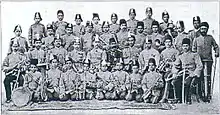Royal Salute (anthem)
"The Royal Salute" (Persian: سلام شاه, romanized: Salâm-e Šâh [sælɒːˈme ʃɒːh]), also known as "The Health of the Shah" (Persian: سلامتی شاه, romanized: Salâmati-ye Shâh [sælɒːmætiːˈje ʃɒːh]) was the royal and national anthem of Persia (Iran) between 1873 and 1909. Alfred Jean Baptiste Lemaire composed this anthem in 1873 on the orders of Naser al-Din Shah.[1][2] It had no lyrics. Salâm-e Shâh was played in official ceremonies during the reign of Naser al-Din Shah, Mozaffar ad-Din Shah and Mohammad Ali Shah. It was also played as Persian national anthem during Naser al-Din Shah’s and Mozaffar ad-Din Shah’s European tours.
| English: Royal Salute | |
|---|---|
| سلام شاه | |
 | |
National anthem of | |
| Music | Alfred Jean Baptiste Lemaire, 1873 |
| Adopted | 1873 |
| Relinquished | 1909 |
| Succeeded by | "Salute of Sublime State of Persia" |
| Audio sample | |
Salâm-e Shâh (1906)
| |

In 1909 after the fall of Mohammad Ali Shah, the anthem was abolished[3] and after coronation of his son and successor Ahmad Shah in 1914, Salute of Sublime State of Persia was adopted as Persian national anthem.[4]
Newer version by Melal orchestra (Irân-e Javân)
This anthem was rearranged, recomposed and orchestrated by the Iranian composer Siavash Beizai. Only the main parts of this hymn are derived from the original version. There are also some harmonic and formal corrections in this piece. The Introduction, the middle part, and the closing part are composed by Siavash Beizai too. After the great popularity of this Anthem, it has been increasingly misused by the official Iranian Radio and Television and the Government without any permission of the cocomposer Siavash Beizai.
Bijan Taraqi was asked by Peyman Soltani, the leader of Melal Orchestra of Iran, to write a lyric for the old national anthem. This new version of the anthem was performed in October 2005 by Melal Orchestra of Iran. The singer of this version is Salar Aghili.
"Irân-e Javân" (Persian: "ايران جوان") means "Young Iran" in English. It is also known as "Vatanam" (Persian: "وطنم"), which means "My Homeland".
References and notes
- Advielle, Victor (February 1974). Translated by Hossein-Ali Mallah. "La Musique chez les Persans en 1885" [Musiqi nazde Iraniyan dar 1885 miladi (Music among Iranians in 1885)]. Honar o mardom (Art and people) (in Persian). Tehran, Iran: Culture and art ministry of Iran. Retrieved 12 July 2014.
- Piemontese, Angelo M. (1974). Translated by Khosrow Fanian. "An Italian Source for the History of Qāǧār Persia: the Reports of General Enrico Andreini (1871-1886)" [Yek ma'khaze tarikhi darbareye Qajariye: Gozareshhaye zheneral Enrico Andreini (1871-1886)]. Barrasihaye tarikhi (Historical studies) (in Persian). Tehran, Iran: Staff of Iranian armed forces - Committee of military history. Retrieved 12 July 2014.
- Khaleqi, Ruhollah (1998). Sargozaghte musiqiye Iran [The story of Iranian music] (in Persian). Tehran, Iran: Safi-Ali Shah. ISBN 964-5626-22-6.
- "Sorud-e melli (National anthem)". Asr-e Jadid newspaper (in Persian). Second year (8). Tehran, Iran. 2 October 1915. pp. 5–6.